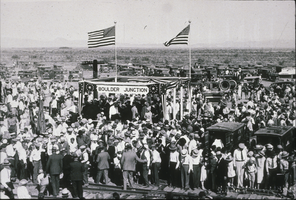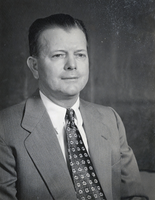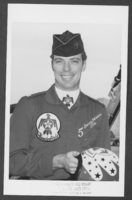Search the Special Collections and Archives Portal
Search Results

Slide of Hoover Dam's downstream side, circa mid 1930s
Date
1935 to 1936
Archival Collection
Description
Black and white image of a man looking at Hoover Dam's downstream face and the outlet works in the walls of Black Canyon. Note: Boulder Dam was officially renamed Hoover Dam in 1947.
Image

Slide of Hoover Dam's upstream side, circa late 1930s
Date
1936 to 1940
Archival Collection
Description
Black and white montage of a person sitting in a small boat near Hoover Dam's upstream side. The lake and canyon portion of the image look to be from a photograph, but the dam seems to be a drawing. Note: Boulder Dam was officially renamed Hoover Dam in 1947.
Image

Slide of Hoover Dam's upstream side, circa late 1930s
Date
1936 to 1940
Archival Collection
Description
Black and white montage of a person sitting in a small boat near Hoover Dam's upstream side. The lake and canyon portion of the image look to be from a photograph, but the dam seems to be a drawing. Note: Boulder Dam was officially renamed Hoover Dam in 1947.
Image

Slide of Hoover Dam's upstream side, circa late 1930s
Date
1936 to 1940
Archival Collection
Description
Black and white image of Hoover Dam's crest and a sailboat on Lake Mead, as seen from the Nevada upstream side of the dam. Note: Boulder Dam was officially renamed Hoover Dam in 1947.
Image

Slide of Hoover Dam power generators, circa mid 1930s-1940s
Date
1935 to 1949
Archival Collection
Description
Black and white image showing an interior view of the Hoover Dam powerhouse. Note: Boulder Dam was officially renamed Hoover Dam in 1947.
Image

Slide of a crowd at the Boulder Junction near Las Vegas, September 1930
Date
1930-09
Archival Collection
Description
Black and white image of a crowd of people gathered together for the Boulder Junction, a ceremony celebrating the beginning of work on Boulder Canyon Project and the beginning of construction on a Union Pacific Railroad from Boulder Junction (Bracken Junction) to the dam site. Note: Boulder Dam was officially renamed Hoover Dam in 1947.
Image

Photograph of Jean R. Walton, Escondido, California, circa 1960s-1970s
Date
1960 to 1979
Archival Collection
Description
A portrait of Jean R. Walton, an acting project engineer for the San Diego Project, in Escondido, California.
Image

Photograph of Jim Epting, Nellis Air Force Base, Nevada, January 19, 1981 or 1982
Date
1981-01-19
Archival Collection
Description
U.S. Air Force Thunderbirds executive Jim Epting, Nellis Air Force Base, Nevada.
Image

Photograph of "Monty" Montgomery, Nellis Air Force Base, Nevada, January 19, 1981 or 1982
Date
1981-01-19
Archival Collection
Description
U.S. Air Force Thunderbirds maintenance officer "Monty" Montgomery, Nellis Air Force Base, Nevada.
Image

Photograph of Sonny Childers, Nellis Air Force Base, Nevada, January 19, 1981 or 1982
Date
1981-01-19
Archival Collection
Description
U.S. Air Force Thunderbirds solo pilot Sonny Childers, Nellis Air Force Base, Nevada.
Image
Pagination
Refine my results
Content Type
Creator or Contributor
Subject
Archival Collection
Digital Project
Resource Type
Year
Material Type
Place
Language
Records Classification
